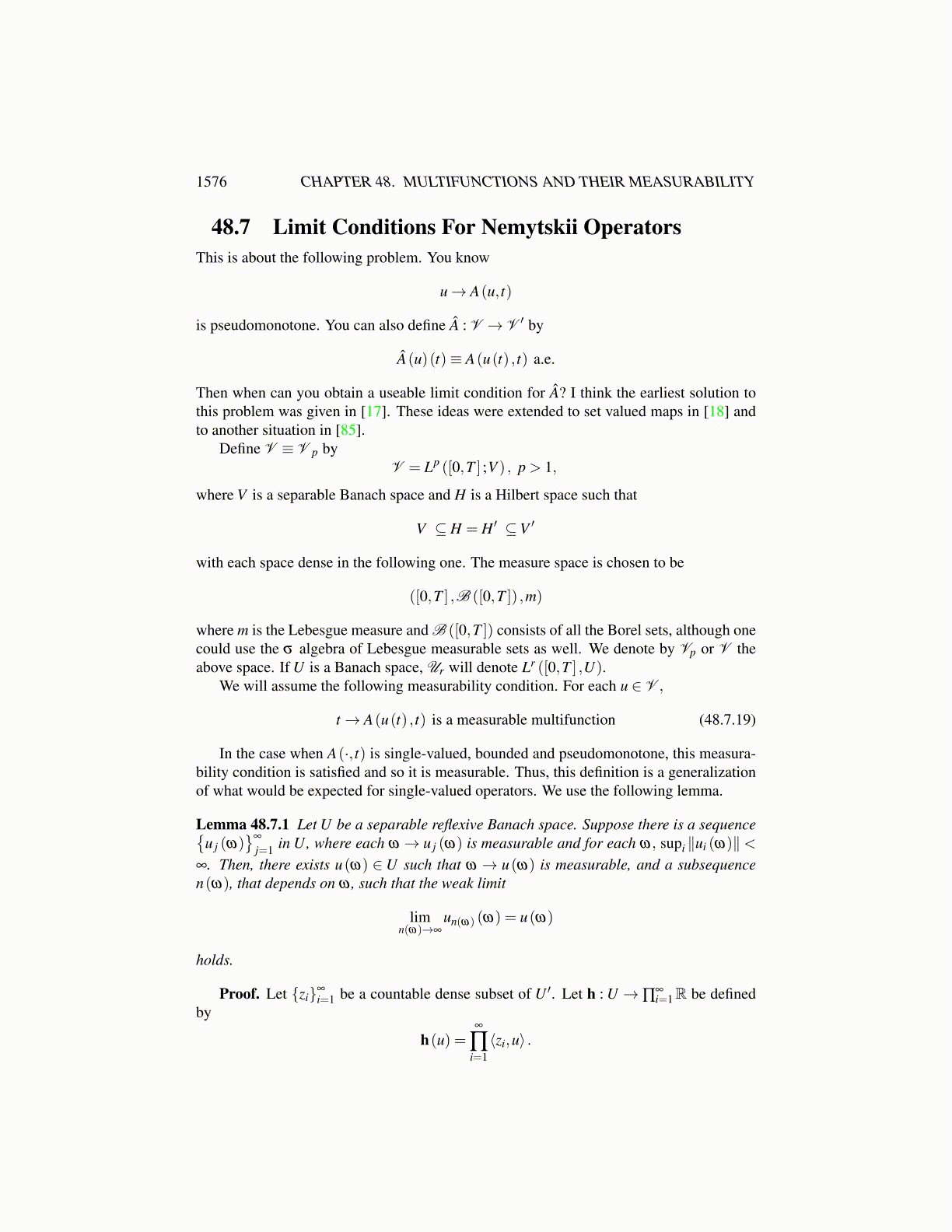
1576 CHAPTER 48. MULTIFUNCTIONS AND THEIR MEASURABILITY
Lemma 48.6.1 Let F be those points where u = 0. Then for a.e. x ∈ F,∇u(x) = 0. Hereu ∈W 1,p (Ω) and we assume ∂Ω has measure zero.
Proof: It suffices to consider u = 0 on F contained in the interior of Ω. First I showthat u,xn = 0 a.e.
u(t1, · · · , tn−1, tn)−u(t1, · · · , tn−1, tn−h)h
=1h
∫ tn
tn−hu,xn (t1, · · · , tn−1,s)ds
Then a.e. tn is a Lebesgue point of u,xn for F(t1,··· ,tn−1)where F(t1,··· ,tn−1) consists of thosepoints of F where (t1, · · · , tn−1) is fixed. Also let tn be a point of density of F(t1,··· ,tn−1). Ofcourse m1 a.e. points of F(t1,··· ,tn−1) are points of density. Therefore, there exists a sequencehk→ 0+ such that tn−hk→ tn as k→∞ and (tn−hk)∈ F(t1,··· ,tn−1). Otherwise there wouldbe some open set about tn which excludes points of F(t1,··· ,tn−1) which would imply that tnis not actually a point of density. Then using the fundamental theorem of calculus, we getfor such points which are points of F(t1,··· ,tn−1) the fact that u,xn (t1, · · · , tn−1, tn) = 0. Thusfor a.e. tn ∈ F(t1,··· ,tn−1),u,xn (t1, · · · , tn−1, tn) = 0. Thus u,xn (t1, · · · , tn−1, tn) = 0 for a.e. tn inF(t1,··· ,tn−1). Similar reasoning holds for differentiation with respect to the other variables.Thus ∇u = 0 a.e. on F .
Lemma 48.6.2 Let V be a closed subset of W 1,p (Ω) , p> 1 and let k∈V. Then max(k,u)∈V and if un→ u in V, then max(un,k)→max(u,k) in V.
Proof: We consider ψ (r) = |r| ,ψε (r) =√
ε + r2. Then for φ ∈C∞c (Ω) ,∫
Ω
ψ (u(x))φ ,xk (x) = limε→0
∫Ω
ψε (u(x))φ ,xk (x)
= − limε→0
∫Ω
u(x)√ε +u2 (x)
u,xk (x)φ (x)
= −∫
Ω
ξ (u(x))u,xk (x)φ (x)
where ξ (r) = 1 if r > 0,−1 if r < 0 and 0 if r = 0. Thus ψ (u) ,xk = ξ (u(x))u,xk (x) a.e.and so ψ ◦ u is clearly in W 1,p (Ω). Of course max(u,k) = |k−u|+(k+u)
2 so this shows thatmax(u,k) is in W 1,p (Ω) .
Next suppose un→ u in W 1,p (Ω) . Does
ξ (un)un,xk→ ξ (u)u,xk ?
Let G = {x : u(x) ̸= 0} . A subsequence, still denoted by un converges pointwise a.e . to uand un,xk→ u,xk pointwise a.e. Therefore, off a set of measure zero, ξ (un (x)) = ξ (u(x))for all n large enough on G. Also,(∫
Ω
∣∣ξ (un)un,xk−ξ (u)u,xk
∣∣p)1/p
≤(∫
Ω
∣∣ξ (un)un,xk−ξ (un)u,xk
∣∣p)1/p
+
(∫Ω
|ξ (un)−ξ (u)|p∣∣u,xk
∣∣p)1/p
(*)